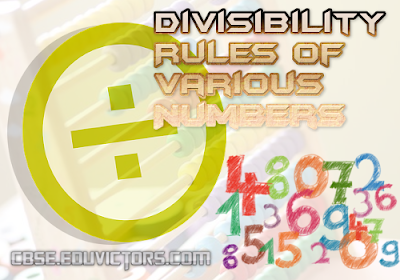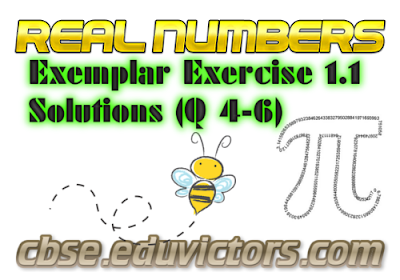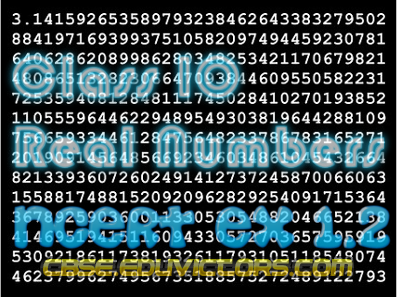Blog provides NCERT solutions, CBSE, NTSE, Olympiad study material, model test papers, important Questions and Answers asked in CBSE examinations. References to Educational Sites and resources.
Showing posts with label class10-maths. Show all posts
Showing posts with label class10-maths. Show all posts
Sunday, 16 September 2018
Friday, 24 August 2018
Divisibility Rules of Various Numbers - CBSE Class 6-12 - NTSE, Entrance Tests - Mathematics Tips (#cbsenotes)(#entrancetests)(#eduvictors)
Divisibility Rules of Various Numbers
(2-25)
A number is divisible by 2 if its unit’s digit is even or 0.
Divisibility by 3:
A number is divisible by 3 if the sum of its digits are divisible by 3.
Divisibility by 4:
A number is divisible by 4 if the last 2 digits are divisible by 4, or if the last two digits are 0’s.
Divisibility by 5:
A number is divisible by 5 if its unit’s digit is 5 or 0.
Divisibility by 6:
A number is divisible by 6 if it is simultaneously divisible by 2 and 3.

Wednesday, 8 August 2018
CBSE Class 10 - Pair of Linear Equations In Two Variables - Solved Examples (#cbsenotes)(#eduvictors)
Pair of Linear Equations In Two Variables
Solved Examples
Q1: Solve the following system of linear equations by elimination method (equating the coefficients).
6 (ax + by) = 3a + 2b
6 (bx – ay) = 3b – 2a
Answer:
Given equations :
6 (ax + by) = 3a + 2b ...(1)
6 (bx – ay) = 3b – 2a ...(2)
multiply eqn. (1) by a and equation (2) by b, and add, we get
6a²x + 6aby = 3a² + 2ab
6b²x – 6aby = 3b² – 2ab
────────────────────────
6 (a² + b²)x = 3(a + b)
────────────────────────
⇒ x = ½
Put x = ½ in equation (1), we have
6a × ½ + 6by = 3a + 2b
6by = 2b
⇒ y = ⅓
∴ x = ½ and y = ⅓ (Answer)

Monday, 30 July 2018
CBSE Class 10 - Maths - Introduction to Trigonometry - Short Q and A (#cbsenotes)(#eduvictors)
Introduction to Trigonometry
Short Q and A
Q1: If sin 3A = cos (A – 26°), where 3A is an acute angle, find the value of A.
Answer: sin 3A = cos (A – 26°)
∵ sin 3A = cos (90° – 3A)
∴ cos (90° – 3A) = cos (A – 26°)
Since
90° – 3A and A – 26° are both acute angles, therefore,
90° – 3A = A – 26°
⇒ A = 29°
Q2: Express cot 85° + cos 75° in terms of trigonometric ratios of angles between 0° and 45°.
Answer: cot 85° + cos 75° = cot (90° – 5°) + cos (90° – 15°)
= tan 5° + sin 15°

Wednesday, 6 June 2018
CBSE Class 10 - Maths - Real Numbers (NCERT Exemplar Solutions Ex 1.1 Q4-6) (#cbsenotes)(#eduvictors)
Real Numbers
(NCERT Exemplar Solutions Ex 1.1)
If the HCF of 65 and 117 is expressible in the form 65m − 117, then the value of m is
(A) 4
(B) 2
(C) 1
(D) 3
Answer: (B) 2
Explanation:
Using Euclid’s division algorithm,
b = aq + r, 0 ≤ r < a [∵ dividend = divisor × quotient + remainder]
⇒ 117 = 65 × 1 + 52
⇒ 65 = 52 × 1 + 13
⇒ 52 = 13 × 4 + 0
∴ HCF (65, 117) = 13 .... (i)
Also, given that, HCF (65, 117) = 65m – 117 ... (ii)
From Equations (i) and (ii), we get
65m − 117 = 13
⇒ 65m = 130
⇒ m = 2

Sunday, 3 June 2018
CBSE Class 10 - Maths - Real Numbers (NCERT Exemplar Solutions Ex 1.1 Q1-3) (#cbsenotes)(#eduvictors)
Real Numbers (NCERT Exemplar Solutions Ex 1.1)
Question 1:
For some integer m, every even integer is of the form
(A) m
(B) m + 1
(C) 2m
(D) 2m + 1
Answer: (C) 2m
Explanation:
Even integers are -4, -2, 0, 2, 4, 6 ...
Let m = integers[Since, here integer is represented by m]
such that m = ⋯ , −1, 0, 1, 2, 3, ...
∴ 2m = ⋯ , −2, 0, 2, 4, 6, ...
∴ even integers can be represented in the form of 2m

Tuesday, 8 May 2018
CBSE Class 9 - Lines and Angles - Brain Teaser (#cbsenotes)(#eduvictors)
Lines and Angles - Brain Teaser
Q: What is the measure of ∠A + ∠B + ∠C + ∠D + ∠E in the figure given below, assuming no angles and sides are equal. Give reason to your answer.
Answer:

Wednesday, 25 April 2018
CBSE CLASS 10 - Maths - Real Numbers (NCERT Exercise 1.2) (#cbsenotes)(#eduvictors)
Real Numbers (NCERT Exercise 1.2)
Q1: Express each number as product of its prime factors:
(ⅰ) 140
(ⅱ) 156
(ⅲ) 3825
(ⅳ) 5005
(ⅴ) 7429
Answer:
(ⅰ) 140 = 2 × 2 × 5 × 7 = 2 2 × 5 × 7
(ⅱ) 156 = 2 × 2 × 3 × 13 = 2 2 × 3 × 13
(ⅲ) 3825 = 3 × 3 × 5 × 5 × 17 = 3 2 × 5 2 × 17
(ⅳ) 5005 = 5 × 7 × 11 × 13
(ⅴ) 7429 = 17 × 19 × 23

Thursday, 11 January 2018
Thursday, 16 November 2017
Monday, 25 September 2017
Thursday, 24 August 2017
Maths Pearls - What is so special about Srinivasa Ramanujan's Magic Square? (#cbseNotes)
What is so special about Srinivasa Ramanujan's Magic Square?
You may be familiar with magic squares. Srinivasa Ramanujan also designed his own magic square.
This magic square looks similar to any other square. What is so special about it?
Sum of any rows is 139

Tuesday, 1 August 2017
CBSE Class X Mathematics - Chapter 3 - Linear equation in two variables - Revision Questions (#cbseNotes)
Chapter 3 - Linear equation in two variables - Revision Assignment
Class X Mathematics
1. The sum of two numbers is 6 and their difference is 4. Find the numbers
2. The sum of two numbers is 15. If the sum of their reciprocals is 3/10. Find the numbers
3. The sum of two numbers as well as the difference between their squares is 9. Find the numbers
4. If we add 5 to the denominator and subtract 5 from the numerator of a fraction, it reduces to 1/8. If we subtract 3 from the numerator and add 3 to its denominator, it reduces to 2/7. Find the fraction

Sunday, 9 April 2017
CBSE Class 10 - Maths - Number Systems - Problems and Solutions (#cbsenotes)
Number Systems
Problems and Solutions
(CBSE Class 10)
Q1: Find HCF and LCM of 126 and 156 using prime factorization method.
Answer: HCF of 126 is:
126
╱╲
2 63
╱╲
3 21
╱╲
3 7
∴ 126 = 2 × 3 × 3 × 7 = 2 × 3² × 7
HCF of 156 is:
156
╱╲
2 78
╱╲
2 39
╱╲
3 13
∴ 156 = 2 × 2 × 3 × 13 = 2² × 3 × 13
∴ HCF (126, 156) = product of common factors with lowest power
= (2ⁱ × 3ⁱ) = 6

Thursday, 16 March 2017
Friday, 10 February 2017
Wednesday, 8 February 2017
Saturday, 10 December 2016
CBSE Class 10 - Maths - Arithmetic Progressions ( Questions and Answers)
Arithmetic Progressions
Class 10 NCERT Exemplar Chapter Solutions
Q 1(MCQ): In an AP, if d=-4,an=7 and an=4, then a is equal to
(a) 6
(b) 7
(c) 20
(d) 28
Answer: (d) In an AP, an=a+(n-1)d
⇒ 4=a+(7-1) (-4)
⇒ 4=a+6(-4)
⇒ 4+24=a
∴ a=28
Q 2(mcq): In an AP, if a=3.5,d=0 and n=101, then an will be
(a) 0
(b) 3.5
(c) 103.5
(d) 104.5
Answer: (b) 3.5
For an AP, an =a+(n-1)d=3.5+(101-1)×0
∴ =3.5
Q 3(mcq): The list of numbers are -10,-6,-2,2,.... is
(a) an AP with d=-16
(b) an AP with d=4
(c) an AP with d=-4
(d) not an AP
Answer: (b) The given numbers are -10,-6,-2,2...is
Here, a1 = -10,
a2 = -6,
a3 = -2
and a4 =2...
Since, a2 - a1 = -6-(-10)
= -6+10=4
a3-a2= -2-(-6)
=-2+6=4
a4-a3=2-(-2)
=2+2=4
Each successive term of given list has the same difference i.e.,4.
So, the given list forms an AP with common difference, d=4.
Q 4(mcq): The first four terms of an AP whose first term is -2 and the common difference is -2 are
(a) -2,0,2,4
(b) -2,4,-8,16
(c) -2,-4,-6,-8
(d) -2,-4,-8,-16
Answer: (c) -2,-4,-6,-8
Let the first four terms of an AP are a,a+d,a+2d and a+3d.
Given, that first term, a=-2 and common difference, d=-2, then we have an AP as follows
-2,-2,-2,-2+2(-2),-2+3(-2)
= -2,-4,-6,-8

Friday, 28 October 2016
CBSE Class 9, 10, 11, 12 - Mathematics - Know about Special Constants
Know about Special Constants
Change is the only constant in our lives. However, there are constants or constant numbers that are frequently used in the domains of Science, Mathematics, Economics etc.
Do you know what is golden ratio?
What is the value of Pi?
What are transcendental numbers?
What's the value of cube root of 2?

Monday, 10 October 2016
CBSE - Class 6-12 - Mathematics - Important Formulas
Mathematics - Important Formulas
eduvictors.com has added a new section "Mathematics" and has compiled important formulas on different topics.
Here is the list of Mathematics formulas:
1. Algebra Formulas
⓵ Polynomials
⓶ Fractions
⓷ Algebraic Identities
⓸ Exponents
⓹ Roots

Subscribe to:
Posts (Atom)






